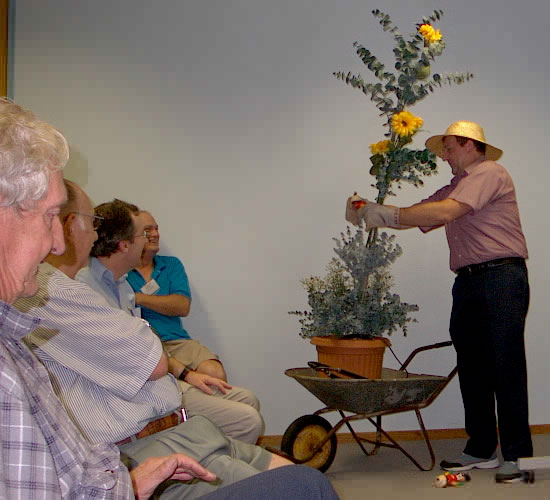Flower Pots
Why the name “Flower Pot”?

Flower Pot antenna presentation to the Hornsby and Districts Amateur Radio Club (HADARC) in early 1993
The photo above really says it all. At a talk I gave at a Hornsby and Districts Amateur Radio Club (HADARC) meeting in early 1993, I (lightheartedly) showed that by placing plastic flowers over this antenna, you can effectively disguise it. This could be particularly helpful if you lived in a home-unit and did not want your neighbours to realise you had a transmitting antenna. As you can clearly see in the above photo, unless your neighbour holds a Masters Degree in Horticulture, he/she would not be able to identify the pot plant as a radio antenna (hi hi)! Other suggestions made at the time included making a fake patio umbrella but the name “Flower Pot” has stuck for the last 14 or so years.
The antenna is constructed as a co-axially, end-feed antenna using co-ax cable feedline as the antenna elements with a resonant choke formed in the co-ax line to provide isolation between antenna elements and the feedline and, the antenna enclosed in PVC conduit or similar plastic pipe.
Some Background
I first constructed one of these antennas in 1993 based on an article by Ian Keenan, VK3AYK published in AR Magazine of May 1986. But to get VK3AYK’s dimensions to resonate and to broaden its response across the 2m band, I had to add a small capacitor hat to the top element. With this modification, many of these antennae were built by HADARC members and have given excellent service for over ten years as both home QTH and portable antennae.
Having a strong interest in 6m FM, I also attempted at the time to adapt the design to this band; however, I was unable to directly scale the design to work (ie, achieve a low VSWR) on 6m.
During the 90s, I regularly revisited my attempts to scale the antenna to 6m but was always unsuccessful. Further inspiration came from another magazine article by Rolf Brevig LA1IC in CQ August 1999 entitled “Feedline Verticals for 2 and 6 Meters”. This article gave a set of formulae for co-axial dipoles. These were ‘bare bone’ construction, ie they were not encased in any type of radome. Encasing the antenna in PVC conduit or plastic water pipe can pull the resonance down by 2 to 3% (depending on material), so allowance for this has to be made when encasing this style of antenna in a radome.
Adapting VK3AYK’s original design and using the information provided in LA1IC’s article, I was able to achieve a half-wave antenna design which will readily scale to any frequency. I have also developed two higher-gain versions (a single 5/8 and a double 5/8) of the antenna which also scale to any desired design frequency.
About 5 years ago (during 2002), I described the half-wave and higher-gain versions to a number of Sydney and NSW Country Clubs and have now since collected sufficient feedback from builders to verify that the designs and their expected performance can be readily replicated. They have proven to be robust designs, very easy to build, rugged and, because of both the inherent simplicity and replicity, are very suitable as an antenna project for Foundation Licensees (the entry-level amateur radio licence that has been introduced in Australia).
More recently, I have designed a simple dual band modification for the half wave antenna.
If you build any of these antennae
I would very much appreciate a report on your success. Hopefully, you should not experience any problems but, of course, in the event that happens, I also want to know about it.
I need feedback from builders to validate the designs and ensure the performance can be easily replicated. My aim is for a Foundation Licensee to be able to build one of these antennae and have it work first time.
Articles
Half-Wave Flower Pot Antenna
The basic 2m half-wave version of the antenna.
Dual Band Half-Wave Flower Pot Antenna
Modified half-wave Flower Pot to dual band the antenna for operation on a band that is the (approximate) third harmonic of the fundamental resonance.
Single 5/8 Flower Pot Antenna
Substitutes a 5/8 wave-length section for the top quarter wave of the basic half wave antenna design.
Double 5/8 Flower Pot Antenna
Extension of the Single 5/8 and uses a 5/8λ element for both the top and bottom radiators.
Experimental Dual Band High Gain Flower Pot Antenna
An extension of the basic Half-Wave Flower Pot, higher gain is achieved by adding an additional half wave element.